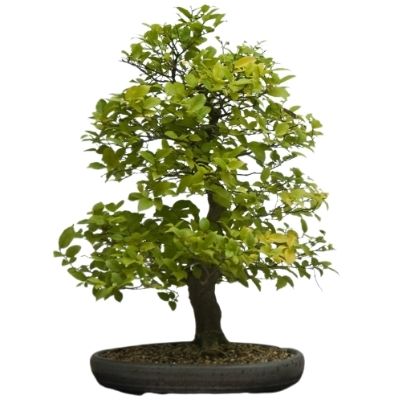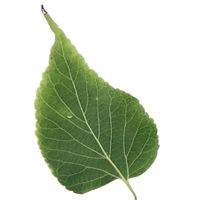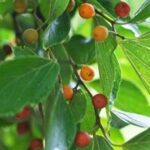
Chinese Hackberry
(Celtis sinensis)
Country of Origin : China
Bonsai Styles : Informal upright, slanting, semi-cascade, cascade, root-over-rock, twin-trunk, clump, straight line, sinuous
Zone : 6 – 9
Chinese hackberry (also sometimes referred as Japanese hackberry) is native to eastern China, Korea and Japan.
Known for its small oval leaves and fine twigs, Chinese hackberry trees are deciduous.
In spite of being fully hardy, this species is often sold as an indoor bonsai. There is probably a reason for this, since it is commercially produced in China, where nearly all half-hardy and tender bonsai originate.
This species is ideal for bonsai because its leaves and internodes reduce well when trimmed and pinched, and it back-buds profusely.
The Chinese hackberry bonsai will bear small flowers. However the flowers seem to be insignificant in comparison to the bright orange fruits of the celtis sinensis bonsai tree.
This bright orange fruit is particularly striking and unique among deciduous bonsai trees
In temperate climates however, the fruit tend not to set well, so special techniques are needed to encourage better fruit setting.
The light gray bark of the trunk is smooth to finely rough and characterized by distinct level scars ( almost every 3 inches). Most trunks have furrows that widen as they approach the base.

Leaf of Chinese Hackberry bonsai tree.

Small white flowers of Chinese Hackberry tree.

Chinese Hackberry bonsai tree fruit. The fruits start with green color before they turn yellow and eventually bright orange.
Best location keep Chinese Hackberry Bonsai
As long as the conditions are right, Chinese hackberry bonsai trees can be kept inside.
The first requirement is that it receives good light. Secondly, because the tree is deciduous, it must have a dormant period.
When it’s outside, these conditions occur naturally. Indoors however, you have to create these conditions artificially.
In temperate climates, Chinese hackberry bonsai tree can be kept outdoors where winter temperatures do not fall below 23°F (-5°C).
Note: Chinese hackberry bonsai trees which are imported from China should be treated as indoor bonsai.
Ideally, if you have a balcony or window sill that is protected from the wind, then this would be the perfect situation.
A sunny location outside in the summer is helpful for Chinese hackberry plants, just as it is for many other indoor bonsai.
In winter, when the Chinese hackberry bonsai tree has shed its leaves, it is best to place it in a cool room. A temperature of no more than 46°F (8°C) is ideal for it to remain dormant and bloom the following year.
Propagation Chinese Hackberry
Chinese hackberry tree can be planted via cuttings, layering, and air layering.
Watering Chinese Hackberry Bonsai
During the growing season, Celtis likes lots of water, and it will quickly wilt or drop leaves once the roots begin to dry out.
The root rot will also occur if the soil remains wet, especially if the tree is not growing strongly or if it is in a dormant state.
During the growing season, water the Chinese hackberry bonsai tree generously and regularly as soon as the bonsai soil surface feels dry.
During the winter, make sure the bonsai soil is just moist when the bonsai tree is dormant.
In waterlogged soil, this species cannot survive.
Whenever the air in a room is very dry, it is advisable to mist it.
Wiring Chinese Hackberry Bonsai
Most of the Chinese hackberry bonsai tree shaping is done by pruning the bonsai tree.
However, in case you are trying to train the bonsai tree with wires, it can be done from spring to fall.
Pruning Chinese Hackberry Bonsai
When to prune Chinese hackberry bonsai?
During the growing period, prune to shape regularly.
You can prune branches between leaf-fall and spring.
Congestion should be thinned out and overgrown areas should be pruned in midsummer to induce rapid new growth.
For permanent removal of certain branches and shaping of the bonsai tree, you can perform pruning in the dormant season.
Cut back new growth after blooming and again at the end of the season in late fall.
Pinching Chinese Hackberry Bonsai
New shoots with three or four buds should be pinched back to just one or two buds.
Repotting Chinese Hackberry Bonsai
When to repot Chinese hackberry bonsai?
Younger Celtis sinensis bonsai tree should be repotted annually. Older Chinese hackberry bonsai trees can be repotted every two years.
Repotting can be performed in Spring.
Consider adding extra coarse organic matter or calcined clay to your Akadama or standard bonsai soil mix to improve water retention.
While using Akadama, make sure that your Chinese hackberry bonsai tree is provided with extra shade and be careful while watering the tree.
OR
You can also use one part coarse sand and two parts loam for your bonsai soil mix.
OR
Or you can use 40% grit and 60% organic matter.
Must Read: Bonsai Soil Recipes
Feeding Chinese Hackberry Bonsai
Feed with balanced feed in spring, then low-nitrogen throughout the rest of the growing season. Once in fall, use a nitrogen-free feed.
OR
During spring and summer, apply low nitrogen feed. Between leaf fall and late summer, apply nitrogen-free feed.
OR
Use a weak solution of liquid fertilizer every two weeks during the growing season. Once summer ends, stop fertilizing.
Diseases and pest of Chinese Hackberry Bonsai
Scaled insects and red spider mites are sometimes found on these bonsai trees, as with many indoor bonsai trees.
Although rarely, aphids can also infest the Chinese hackberry bonsai tree. These trees are mainly attacked by scale insects and spider mites.
You can pick off aphids by hand and spray mist to keep red spider mites at bay.
Spraying a water jet at the affected shoots when your plants are in the sun outside in the summer often flushes out the insects.
Applying a systemic insecticide may help in the case of persistent infestations.
Other than that, Chinese hackberry bonsai is a trouble-free tree.
Small spots on leaves are caused by a number of microscopic fungi, but they can easily be eliminated by eliminating and destroying the affected leaves.
Chinese Hackberry bonsai care
Both indoors and outside, hackberry prefers really hot summers that promote plentiful fruiting. The plant does well in a humid climate and in soils that have plenty of moisture.
Spray the tree several times a day from spring through summer, and place it near or over a tray of water in order to maintain high local humidity. Bring the tree into the kitchen on cool evenings to maintain the temperature and humidity.
In order to prevent them from ‘leaning’ towards the light source, they should be turned regularly.
The roots will remain healthy with regular repotting.
It will be easier to maintain your Chinese hackberry bonsai if you use a deeper container.
In extremely hot weather or on a sunny windowsill, shading the pots from full sun will help retain water and keep the roots healthy.
An overworked tree won’t grow and will eventually die by the coming spring if it doesn’t get a proper rest period (dormant season) during the winter months. Hence, avoid encouraging the tree to grow year round.
Important Note :
The growth of Chinese hackberry bonsai can be quite rapid.
Once shoots have grown until they have a large number of leaves (8-10) on them, if they are then severed off back to one or two leaves, a cluster of smaller shoots will emerge from around the wound and along the branch’s length. As the fine twigs grow from these branches, they will quickly form a dense canopy.
Flowering and fruiting will decrease as twigs become dense.
The choice is yours whether you want a finely developed bonsai tree form or a less treelike, but more attractive, fruit-bearing Chinese hackberry bonsai tree.
What to look for when buying Chinese Hackberry Bonsai
Chinese hackberry trees found in nurseries are trimmed frequently. This frequent trimming results in these trees having fine twigs. These twigs often die back leaving a large gap in the canopy structure of the bonsai tree.
Avoid such Celtis bonsai specimens.

